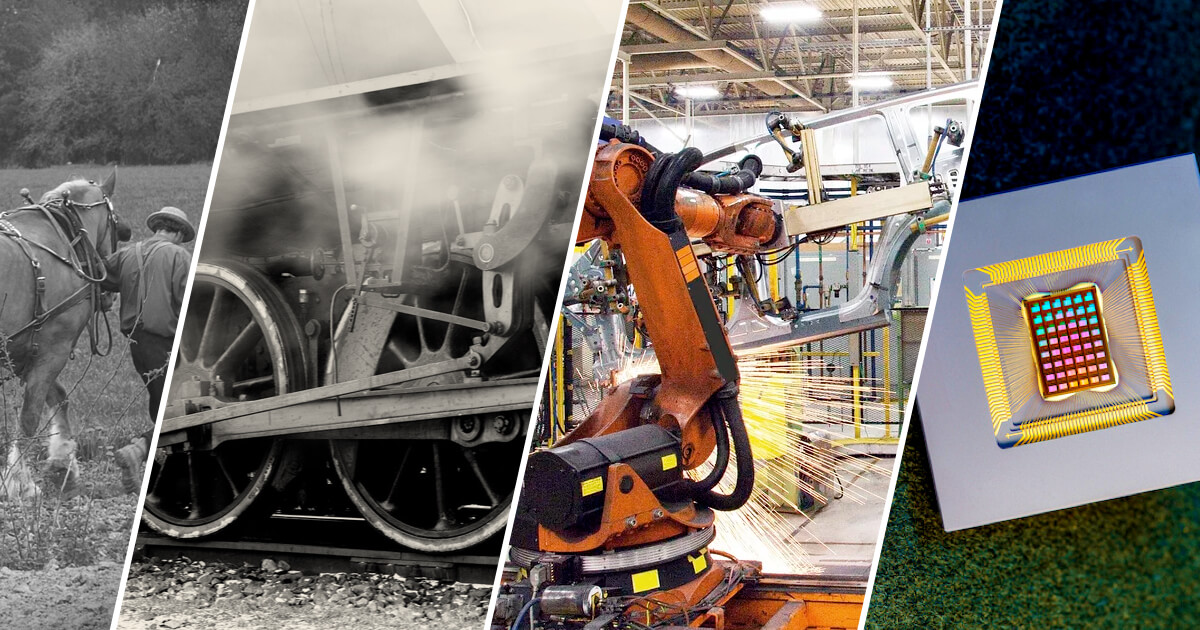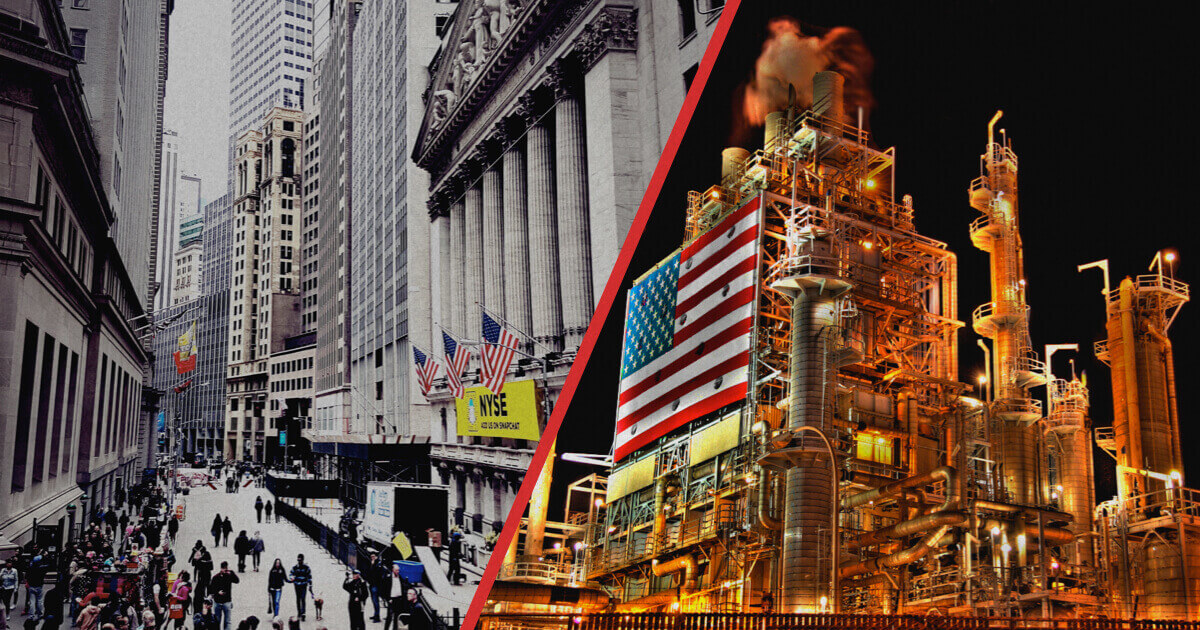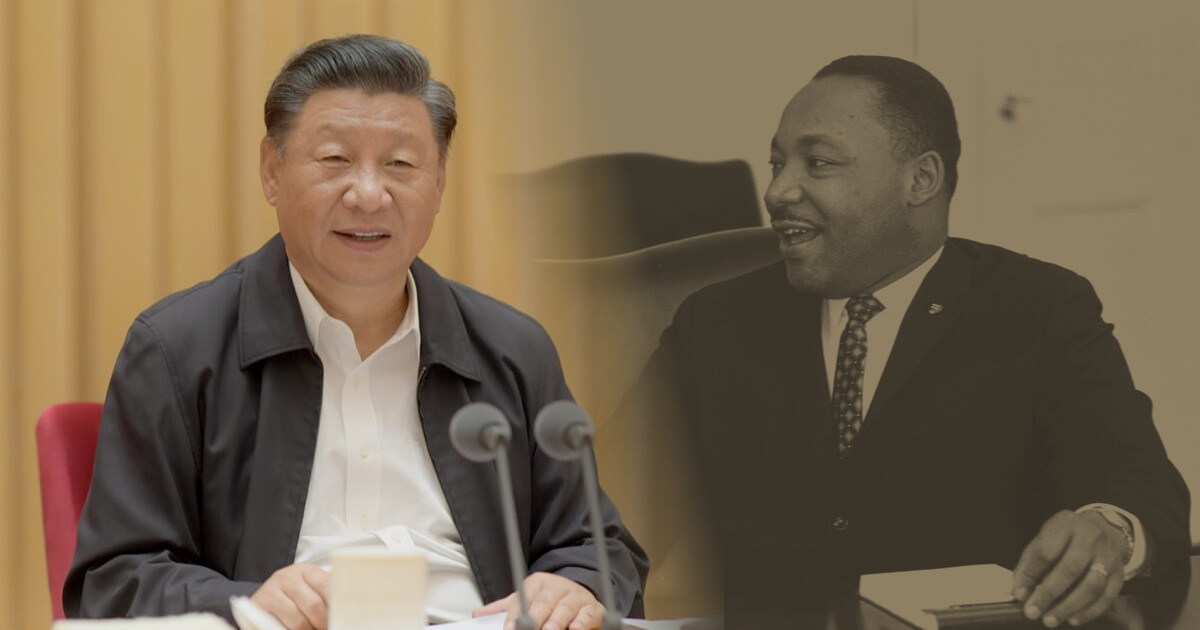“Two Inevitabilities” is Marx and Engels judgement on the trend of the emergence of the socialist society. “Two Nevers” is Marx and Engels’ theoretical exposition on contradictory movement of productive forces and relations of production in the development of human society and its evolution.
Note: This document has been translated from Chinese. -Ed
“Two Inevitabilities” and “Two Nevers” are the most important part of Marxist theory. They together reveal the law of the development of human society, a theory with a high degree of inherent unity. In terms of the development trend of capitalist society, “Two Nevers” judgement is relative and expresses the internal requirements of “Two Inevitabilities”. “Two Inevitabilities” judgement contains the judgement of “Two Nevers” and expresses the final result of “Two Inevitabilities.”
1. “Two Inevitabilities” as the final result of the movement of the “Two Nevers.”
“Two Inevitabilities” and “Two Nevers” together in unity are the embodiment of the basic law of movement of societies.
“Two Nevers” is the embodiment of the general law of contradictory development movement of contradictions in the society and the “Two Inevitabilities” is the final result of this former law which we can clearly observe in the capitalist society.
In Preface to The Critique of Political Economy, when summing up the “overall results” of his economics studies, Marx for the first time clearly revealed the dialectical development process of human society with his classical words and put forward the judgement of “Two Nevers”. Marx pointed out that the production relations that are compatible with the developmental stages of material productive forces are the real basis of society, and “the mode of production of material life determines the social, political and intellectual life process in general” “At a certain stage of their development, the material productive forces of society come into conflict with the existing relations of production, or what is but a legal expression for the same thing-with the property relations within which they have been at work hither-to. From forms of development of the productive forces these relations turn into their fetters. Then begins the epoch of social revolution.” “We cannot judge an epoch of transformation by its own consciousness; on the contrary, instead this consciousness must be explained from the contradictions of material life, from the existing conflict between the social productive forces and the relations of production … No social order ever disappears before all the productive forces for which there is room in it have been developed,” and “new, higher relations of production never appear before the material conditions of their existence have matured in the womb of the old society itself” (the “Two Nevers”).
There is no doubt that the idea of “Two Nevers” discusses the conditions of social revolution and reform and expression Marx’s idea on the general form of basic social contradictions in a society. It tells us that in terms of the general form of the human social movement, any socio-economic form will exist as long as the productive forces it can accommodate can still continue to develop. When the material conditions on which the higher production relations rely on develop and become more mature in the old social form, the higher economic and social form will emerge.
So, Marx put forward the “two nevers” judgement as a dialectical form for the analysis of human social development and change. It is the inherent content of the general law of human social development, and objective criteria for judging the era of social change.
The idea of “Two Nevers” is the consistent thinking of Marx and Engels. In their works such as A Contribution to the Critique of Hegel’s Philosophy of Right-Introduction, The German Ideology, The Poverty of Philosophy and The Communist Manifesto, when explaining the contradictory movement of productive forces and production relations, Marx and Engels made gradually richer and more profound elaborations on the idea of “Two Nevers.”
In Contribution to the Critique of Hegel’s Philosophy of Right, Marx answered the following question: can Germany attain a practice à la hauteur des principles – i.e., a revolution which will raise it not only to the official level of modern nations, but to the height of humanity which will be the near future of those nations?
“Meanwhile, a major difficulty seems to stand in the way of a radical German revolution. Because, revolutions require a passive element, a material basis. Theory is fulfilled in a people only insofar as it is the fulfillment of the needs of that people.”
He also added: “Will the theoretical needs be direct immediate practical needs? It is not enough for thought to strive for realization, but reality must itself strive towards thought.”
By analyzing the specific conditions of the “material basis” i.e. the German productive forces and production relations at the time, Marx argued that the conditions of social revolution in Germany were immature. In practice, it had no social conditions for establishing new productive relations. Marx added: “Only a revolution of radical needs can be a radical revolution and it seems that precisely the preconditions and ground for such needs are lacking (in Germany).”
This text has been the first analysis of social revolution in Marx’s view to change the world, which has initially utilized the dialectical form of social movement analysis and which also contained his first initial thought of “Two Nevers.”
In The German Ideology, Marx and Engels explicitly put forward the concept of “material factors for comprehensive change”, elaborated the connection between the revolutionary mobilization tasks with the situation of productive forces and relations, and the dialectical relationship between material conditions for social change and the forms of social change
They argued:
“This sum of productive forces, capital funds and social forms of intercourse (later this term changed to production relations), which every individual and every generation finds in existence as something given, is the real basis … These conditions of life, which different generations find at their hands, determine also whether or not the revolutionary convulsion periodically recurring in history will be strong enough to overthrow the basis of everything that exists. And if these material elements of a complete revolution are not present – namely, on the one hand the existing productive forces, on the other the formation of a revolutionary mass, which revolts not only against separate conditions of the existing society, but against the existing ‘production of life’ itself, the ‘total activity’ on which it was based then it is absolutely immaterial for practical development whether the idea of this revolution has been expressed a hundred times already, as the history of communism proves.”
This text marks that Marx and Engels’ though of “Two Nevers” had initially taken form.
In the Poverty of Philosophy which “for the first time scientifically” explained “the decisive argument”, when analyzing the contradictory movement of capitalist society, Marx said:
“The bourgeoisie took possession of the productive forces it had developed under feudalism. All the old economic forms, the corresponding civil relations, the old political state which was the official expression of the old civil society, were smashed.”
Before the proletariat has not developed enough to be established as a class, struggle between the proletariat and the bourgeoisie cannot become political, yet.
In reviewing the historical conditions of utopian socialism, he also put forward the idea of “Two Befores”, namely:
“(Before) so long as the proletariat is not sufficiently developed to constitute itself as a class, so long as, in consequence, the struggle between the proletariat and the bourgeoisie has not acquired a political character, and (before) the productive forces are not yet sufficiently developed in the bosom of capitalism itself to enable us to catch a glimpse of the material conditions necessary for the emancipation of the proletariat and for the formation of a new society, these theoreticians are merely utopians…” (The Poverty of Philosophy)
The ideas of “bourgeoisie taking the possession of the productive forces having grown up under the feudal rule” and “Two Befores” are Marx’s scientific judgment on the material conditions of capitalist development, which in fact is the “Two Nevers.”
In the same year, in The Communists and Karl Heinzen, when criticizing Karl Heinzen Engels expressed the same idea:
“Mr. Heinz is extremely ignorant about the conditions for the abolition of private property.”
Engels added:
“Herr Heinzen forcibly and objectively separates the abolition of private property, which is of course the condition for the liberation of the proletariat, from the conditions which are attached to it, when he considers it quite out of all connection with the real world simply as an ivory-tower fantasy, it becomes a pure cliché about which he can only talk latitudinous nonsense … As long as (before) large-scale industry is not so far advanced that it frees itself completely from the fetters of private property, thus long does it permit no other distribution of its products than that at present occurring, Thus, the new product distribution mode will never appear.”
The text Principles of Communism marked that the Marxist theory of “Two Inevitabilities” and “Two Nevers” had become basically mature. In this programmatic document drafted for the Communist League, with a through scientific analysis of the productive forces, the mode of production and the development of ownership relations in the early stages of capitalist society and the pre-capitalist society, Engels has further elucidated the social conditions for the abolition of private ownership, the development trend of capitalist private ownership and other important ideas. These ideas include:
First, the change in ownership relations is the inevitable result of the fact that the old form of ownership is no longer compatible with the new productive forces. Under the condition of this new “social order in which so much is produced that every member of society will be in a position to exercise and develop all his powers and faculties in complete freedom … So long as (before) it is not possible to produce so much that there is enough for all, with more left over for expanding the social capital and extending the forces of production… there must always be a ruling class directing the use of society’s productive forces, and a poor, oppressed class,” which means that before such an abundant production, that social system will never perish.
Secondly, the material conditions for the abolition of private ownership has gradually formed with the development of capitalism after the “initial stage of development of the large-scale industry.” The development of large scale industries itself embodies the material conditions of the abolition of private ownership. Creating the basis and conditions for the abolition of private ownership are the qualitative provisions for the new society. Although at the “initial stage of handicraft workshops and large-scale industry development” there was no possibility for the existence of any other ownership or a social system except for private ownership and private ownership based social systems. The industrial revolution, large-scale industries and the possibility of infinite expansion of production allow people to establish such a new social system, wherein “so much is produced that every member of society will be in a position to exercise and develop all his powers and faculties in complete freedom.”
Thirdly, modern large-scale industries and industrial revolutions have created social conditions for the abolition of private ownership. “The repetitive economic crises” and the “extreme poverty” of workers indicate that this social system cannot adapt to the requirements of current industrial development. The contradiction between social productive forces and production relations caused by the development of large-scale industries “which produce misery and crises are those which, in a different form of society, will abolish this misery and these catastrophic depressions” completely proves that “the abolition of private ownership” is not only possible, but completely necessary.
Fourthly, Engels emphasized the establishment of proletarian political domination and the abolition of private ownership shall be gradually implemented with the conditions determined by “existing productive forces”.
Engels argued that the social revolution in any place and at any time is the inevitable result of a variety of situations that are completely free from the will and leadership of a single political party or a whole mass of class.
Engels discussed:
“Will it be possible for private property to be abolished at one stroke? No, no more than existing forces of production can at one stroke be multiplied to the extent necessary for the creation of a communal society. In all probability, the proletarian revolution will transform existing society gradually and will be able to abolish private property only when the means of production are available in sufficient quantity.”
While the proletarian revolution “above all, will establish a democratic constitution, and through this constitution, thereby the direct or indirect dominance of the proletariat.” This democracy will “be used as a means for putting through measures directed against private property and ensuring the livelihood of the proletariat. … It is impossible, of course, to carry out all these measures at once. But one will always bring others in its wake.”
In the Principles of Communism, as a programmatic document prepared directly as a draft text for the famous next text The Communist Manifesto, Engels clearly explained that the private ownership of the capitalist society, the highest form of private ownership in the history of human society, can only be eradicated when all the productive forces it accommodated are given full play and the material conditions for the new and higher productive relations become mature, otherwise it will never perish.
In The Communist Manifesto – “the complete party program of the proletariat with theoretical and practical significance” – Marx and Engels applied the approach of their new materialism and the cognitive methods of “Two Nevers”, profoundly analyzed the development of capitalist economic and social relations, and capitalist social productive forces and relations and their contradictory movement, and made the historic conclusion that “the demise of the bourgeoisie and the victory of the proletariat are both inevitable” (namely the “Two Inevitabilities”).
If we can say that before the 1848 European revolution, the theory of “Two Inevitabilities” and “Two Nevers” were the conclusions of Marx and Engels based on the analysis of the laws of human society development and the logic of the contradictions of capitalist society, then we can say that the 1848 European revolution has been a test for this theory. After the failure of the European revolution, Marx’s first attempt to explain a piece of contemporary history by means of his new materialist conception, was the work, i.e., The Class Struggles in France, 1848 to 1850. In other words, he used his new materialism to “explain a piece of contemporary history by means of his materialist conception, on the basis of the prevalent economic situation.” In this work, through the analysis of European economic, political situation and its prospects, Marx argued that the social contradictions that caused the European revolution in 1848 were not resolved and predicted that the class struggle would never stop, “as long as there is any new proletarian uprising in France, it is bound to cause a world war.” But, because in capitalist society, especially in the United Kingdom and the United States, the new industrial boom was clearly demonstrated and reached a very high level. Marx analyzed:
“Given this general prosperity, wherein the productive forces of bourgeois society are developing as luxuriantly as it is possible for them to do within bourgeois relationships, a real revolution is out of the question. The foundation of bourgeois social relations are being consolidated at the moment. … Under these conditions, all the reactionary attempts to hold back bourgeois development will rebound … A new revolution is only a consequence of a new crisis. The one, however, is as sure to come so the other.”
On the one hand, Marx firmly believed that the new crisis will come gain when the contradictions between modern productive forces and capitalist mode of production will reach a new stage, but on the other hand, he acknowledged: “the productive forces of bourgeois society are developing as luxuriantly as it is possible for them to do within the framework of bourgeois relationships,” therefore social revolution that eliminates the new crisis is never going to happen. This is another important exposition of Marx’s idea of “Two Inevitabilities” and “Two Nevers.”
More than 40 years later, in 1895, in the Preface he wrote for Karl Marx’s work Class Struggles in France 1848-1850, Engels fully affirmed Marx’s theoretical summary of the 1848 European revolution. Engels pointed out that Marx “demonstrated the inner causal connection in the course of a development which extended over some years, a development as critical, for the whole of Europe, as it was typical. The level of this explanation has been unprecedented … A new revolution is possible only in consequence of a new crisis. It is, however, just as certain as this (author added: new) crisis.”
Engels added:
“But that was the only major change which had to be made in Marx’s work. There was absolutely nothing to alter in the interpretation of events given in the earlier chapters, or in the causal connections established in that chapter, as proved by the continuation of the narrative from March 10 up to the autumn of 1850 in the said review. I have, therefore, included this continuation as the fourth article in the present new edition of the book. “
It is precisely because Marx’s and Engels’ rigorous theoretical analysis of the basic contradictions of human society before 1850 and due to proof of the theories of historical materialism in the European Revolution in 1848 and Marx’s careful study of new phenomena regarding the capitalist society which had entered into a new development stage after 1850 that the later work of Marx, i.e., the Critique of Political Economy could be finished.
In the preface to this new work, Marx finally expressed the idea of “Two Nevers” with his classical words and once again reaffirmed the idea of “Two Inevitabilities”. He wrote:
“The bourgeois mode of production is the last antagonistic form of the social process of production … The productive forces developing within bourgeois society create also the material conditions for a solution of this antagonism. The prehistory of human society accordingly finalizes with this social formation.”
The development trend of the capitalist society is the objective requirement of the dialectical movement of “Two Inevitabilities” and is based on the “Two Nevers”. The above literature shows that: (1) the ideas of “Two Inevitabilities” and “Two Nevers” were the consistent basic idea of Marx and Engels in their whole life and we can never say that the latter can be amended or ignored and latter can be supplementary to the former. (2) The ideas of “Two Inevitabilities” and “Two Nevers” are mutually contradictory, interrelated and complementary and are in unity. (3) “Two Inevitabilities” can be said that it is more deeper or fundamental judgement of Marx and Engels, because they have confirmed that: For a practical materialist, that is for a communist, the thing is to revolutionize the existing world that is, practically turn against things as he finds them, and change them.”
2. The idea of “Two Inevitabilities” contains the idea of “Two Nevers”
The idea of “Two Nevers” discusses the conditions of social revolution and change. In other words, a social form is inevitably going to perish after all the productive forces it accommodates are given full play; and the new and higher production relations will inevitably emerge when their material conditions – including the new productive forces and classes that represent new productive forces developing and becoming mature in the womb of the old society. This is the logic of The Communist Manifesto in demonstrating the theory of “Two Inevitabilities”.
When making the conclusion that “the demise of the bourgeoisie and the victory of the proletariat are both inevitable,” The Communist Manifesto demonstrates the conditions for the demise of the bourgeoisie and the victory of the proletariat. It means that the highly developed productive forces lead to economic crisis that is increasingly endangering the survival of the entire bourgeois society; workers become poorer, poverty is growing faster than population and wealth, and the working class cannot maintain its slave-like living conditions.
The task of The Communist Manifesto was to declare that modern bourgeois ownership must perish. In the Preface to the English Version in 1888, Engels’ brilliantly summarized [that] the “core ideas” of The Communist Manifesto [were] in fact a summary of the logic of argumentation and basic theory of The Communist Manifesto.
In The Communist Manifesto, Marx and Engels made rigorous theoretical arguments for “Two Inevitabilities”, among which said:
“The bourgeoisie has played a most revolutionary part in history … the history of these class struggles forms a series of evolutions in which, nowadays, a stage has been reached where the proletariat cannot attain its emancipation… without, at the same time, and once and for all, emancipating society at large from all exploitation, oppression, class distinction, and class struggles.”
These sentences obviously contain the tea of “Two Nevers”. This argument fully estimates the development trend of capitalist social productive forces and relations, and proves that “Two inevitabilities” is the ultimate result of the movement of capitalist mode of production and the inevitable result of the full development of the material conditions (the contradictions between productive forces and production relations, and between proletariat and the bourgeoisie) for the existence of capitalism with irrefutable facts and logic.
The Communist Manifesto made use of the historical materialist view founded by Marx and Engels, with deep insight discovered the core issues of “modern society,” started from the evolution of the productive forces in the “bourgeois era,” and revealed the contradictory movement of capitalist productive forces and productive relations. The discovery of America and the rounding of the Cape opened up fresh ground for the rising bourgeoisie, and promoted the productive forces of capitalist society.
“The East-Indian and Chinese markets, the colonization of America, trade with the colonies, the increase in the means of exchange and in commodities generally, gave to commerce, to navigation, to industry, an impulse never before known, and thereby, to the revolutionary element in the tottering feudal society, a rapid development.”
The rapid development of the revolutionary forces within the feudal society prompted handicraft workshops to replace the feudal and organizational way of industrial management. The expansion of the market, the increase in demand, especially the revolution in the industrial production caused by the steam and machinery, made a great change: “The place of manufacture was taken by the giant, Modern Industry.”
The establishment of the world market promoted by the modern large industry has promoted great developments to commerce, to navigation, to communication by land, all of which in turn further promoted the industrial expansion. The bourgeoisie has continually promoted the revolution of production tools. From the simple tools to accumulation of tools and to the synthesis of tools, from the synthesis of tools worked by manpower to the tools worked by the use of natural powers, from the machine to “a single machine with an engine” and to “the system of machines working automatically,” and with the application of machinery and steam, the division of labor had further deepened.
“The bourgeoisie has through its exploitation of the world market given a cosmopolitan character to production and consumption in every country… it has drawn from under the feet of industry the national ground on which it stood. All old-fashioned national industries are destroyed or are daily being destroyed.”
Through a series of changes in the mode of production and exchange (trade), “the bourgeoisie, during its rule of scarce one hundred years, has created more massive and more colossal productive forces than have all preceding generations together.”
However, the great development of capitalist productive forces has led to an increasingly sharp contradiction between the development requirements of socialization of productive forces and the private ownership of the means of production. Marx analyzed the revolutionary role of the modern productive forces as follows:
“the history of industry and commerce is but the history of the revolt of modern productive forces against modern conditions of production, against the property relations that are the conditions for the existence of the bourgeois and of its rule … The conditions of bourgeois society are too narrow to comprise the wealth created by them.”
The bourgeoisie can only rely “on the one hand by enforced destruction of a mass of productive forces; on the other, it relies on the conquest of new markets, and by the more thorough exploitation of the old ones. That is to say, by paving the way for more extensive and more destructive crises, and by diminishing the means whereby crises are prevented. … The weapons with which the bourgeoisie knocked down feudalism to the ground are now turned against the bourgeoisie itself.”
Based on the analysis of contradiction movement of productive forces and production relations in modern society and full demonstration the degree of contradiction between productive forces and production relations, Marx and Engels put forward the great and scientific thought of “Two Inevitabilities.”
The theoretical conclusions of the Communists only: “express, in general terms, actual relations springing from an existing class struggle, from a historical movement going on under our very eyes.”
When demonstrating the theory of “Two Inevitabilities” in The Communist Manifesto, Marx and Engels expounded on the true relationships within the history of the modern bourgeois society, they have fully explained the complexity and long-term nature of the contradictory movement between the capitalist productive forces and relations and affirmed conscious and unconscious adjustment on production relations and social relations to adapt to the development of productive forces, which contains the idea of “Two Nevers”. What is the difference between the bourgeois era and all other times of the past?
“Constant revolutionizing of production, uninterrupted disturbance of all social conditions, everlasting uncertainty and agitation distinguish the bourgeois epoch from all earlier ones.”
All previous historical movements were movements of minorities, or in the interest of minorities. The proletarian movement is the self-conscious, independent movement of the immense majority, in the interest of the immense majority. The proletariat, the lowest stratum of our present society, cannot stir, cannot raise itself up, without the whole super-incumbent strata of official society being sprung into the air. According to Marx and Engels:
“The bourgeoisie cannot exist without constantly revolutionizing the instruments of production, and thereby the relations of production, and with them the whole relations of society.”
This means that the constant transformation of production tools and production relations is the basis of the existence of the bourgeoisie. As long as the production tools, production relations and social relations in the capitalist mode of production could be changed, and as long as the relationship between them still allows for the transformation of production tools, the bourgeoisie will be able to survive. In other words, the capitalist society “will never perish until all the productive forces it can take are given full play.”
In fact, in its development process, the bourgeoisie constantly, consciously or unconsciously adjusts the social relations, and changes the means of production and the form of social relations. They run around the world and “settle down, develop and establish contact everywhere”.
They make the production and consumption of all nations cosmopolitan. The local and national self-sufficiency and closed status are replaced with communications and interdependence among all nations. They force all nations to take the bourgeois mode of production. They make the countryside succumb to the rule of the city. Uncivilized and semi-civilized are subordinate to civilized countries. The farmers’ nations are subject to the bourgeois nations. The East is subject to the West. They destroy the scattered state of production, property and population, so that the population is concentrated, the means of production are centralized in the hands of the few and the wealth also in the hands of a few people. The bourgeoisie’s self-adjustment of social relations will reach such a stage, that if the capitalist relations of production are not completely changed, social productive forces will not be further developed. The material conditions for the demise of capitalism and the development of contradictions between productive forces and relations are now fully mature. The era of social change is coming. Marx and Engels’ full demonstration of the development trend of capitalist social productive forces and relations contains a concrete description of “Two Nevers” thought.
The material conditions for the inevitable demise of capitalism also exist in the social relation it has created, namely the contradictions and struggles between the proletariat and the bourgeoisie. The modern bourgeois society that emerged from the demise of feudal society could not eliminate the class antagonism. It merely replaces the old ones with the new class, the new oppressive conditions and the new forms of struggle and makes the whole society increasingly be divided into two directly opposing classes, namely the bourgeoisie and the proletariat. In proportion as the bourgeoisie, i.e., capital, is developed, in the same proportion as the proletariat… so long as their labor increases capital.
“Not only are they slaves of the bourgeois class, and of the bourgeois State; they are daily and hourly enslaved by the machines, by the overlooker, and, above all, by the individual bourgeois manufacturer himself.”
The proletariat is a true revolutionary class, and its struggle with the bourgeoisie begins with its existence. In the struggle, the proletariat kept being tested, their consciousness continued to improve, and their unions continued to expand. Their party organizations “became more powerful and stronger, than ever.”
The proletariat goes through various stages of development. With its birth begins its struggle against the bourgeoisie. At first the contest is carried on by individual laborers, then by the workers of a factory, then in one locality, against the individual bourgeois who directly exploits them. Later they establish trade unions against the bourgeoisie and next organize their political party, with the improved means of communication “the workers from different localities get into contact with one another. It was just this contact that was needed to centralize the numerous local struggles, all of the same character, into one nation-wide struggle between classes.”
This political struggle has now developed to such a stage: if the oppressed proletariat cannot liberate the whole society once and for al from all exploitation, oppression, class differences and class struggles, it will not be able to emancipate itself from enslavement of the ruling and exploiting bourgeoisie.
“The proletariat, the lowest stratum of our present society, cannot stir, cannot raise itself up, without the whole super-incumbent strata of official society being sprung into the air.”
The class struggle based on the capitalist economic relations will surely destroy the bourgeoisie and its political domination and replace it with the political rule of the proletariat. The material conditions of the victory of the proletariat are already there and the higher production relations that will replace the old private ownership have matured in the capitalist society. This is the inevitable result of the development of human society, the ultimate result of the development of capitalism, and the ultimate outcome of the proletariat’s fight against bourgeoisie. The bourgeoisie’s self-adjustment efforts of production relations and social relations has never ceased. In order to adapt to the requirements of socialization of production, contemporary capitalism is still constantly self-adjusting its own production relations and class relations. This self-adjustment is, to some extent, even more comprehensive than the era of Marx and Engels, with a wider scope and greater impacts.
Within the contemporary capitalist system, as the production becomes more and more socialized, the forms of capital is becoming more and more socialized, from the original sole proprietorship to the partnership, then to the joint-stock enterprise form, then to the private monopoly capital, to the state monopoly capital, and finally to multinational corporations and international monopoly capital. All these changes indicate that capitalism is a “society which is not solid crystal, but an organism capable of change, and is constantly changing.”
However, even if a society has discovered the laws its own movement, it can not skip or issue a decree to abolish the natural-historical developmental stages but can only shorten and alleviate the pain of birth. There is a limit to the self-improvement or self-adjustment of capitalism. This limit is the basic economic law of capitalist society created by its basic contradictions (namely the law of surplus value). In capitalist society, the development of productive forces is subject to the limitation of value proliferation of capital. This limitation will restrict the infinite development of productive forces. Capital is always trying to break through these restrictions in the process of developing productive forces and thus need to constantly change its production relations. The problem is that every time this “creative destruction” occurs, it will lead capital falling into a greater crisis, because “the real barrier of capitalist production is capital itself.”
Whether the capitalist society takes laissez-faire measures or planned state intervention into the economy, its foundation is the private enterprise system and its economic purpose is to enable the private enterprise to operate normally in the whole society and assure capital accumulation. If capitalism does not change its greed for surplus value, it is impossible to eliminate the capitalist private ownership of means of production and eliminate its own limitation upon the infinite development of productive forces, thus cannot change the historical trends of “Two Inevitabilities.”
Similarly, the historical trend of “Two Inevitabilities” does not affect the bourgeoisie’s self-adjustment of production relations and social relations at all. The basic contradiction of contemporary capitalism can be softened, but it will still exist. This contradiction works in the long river of history with its inevitability, and will inevitably push capitalism to perishment, regardless of its specific process.
3. We should evaluate the “Two Nevers” as relative
Among the studies on the “Two Inevitabilities” and “Two Nevers” and their relations, there is a kind of opinion that the “Two Inevitabilities” can only be achieved when the contradiction between the productive forces and production relations become fully mature. Since productive forces are the ultimate motive force of social development, the inevitability of socialism replacing capitalism is determined by the level of development of productive forces. Only when the productive forces reach such a height that it cannot be accommodated by the capitalist production relations, the replacement of capitalism with socialism can eventually become a reality.
This view is only a general illustration of the law of human social development and points to the general trend of social development, so it is true only in principle. The problem is that, it will be too simple to use this general approach to illustrate the complex process of human social development, because the decisive factor in the historical process is the production and reproduction of real life. But the historical development process is the result of the interaction of multiple factors. Especially for a country and nation, the various elements of the superstructure and the extensive international communications also influence the process of its historical fate in many cases, and can determine the forms of struggle. In the whole process of world historical development, due to social contradictions and their complexity, the development of human society has both the universal law of social and historical development and also its particular law. The universal law of the development of world history does not exclude the particularity of individual nations, does not exclude countries and regions which can have different development form and development order; on the contrary, the universal law of the development of world history is the general prerequisite. The specific historical development law here refers to the following two cases:
Firstly, when a number of social forms at different stages of development coexist and interact with each other, the social form at the lower stage is likely to skip some of the stages that used to be inevitable to go through and can connect with a higher stage that used to be unconnected due to the guiding effect of the higher society, thus leads to a situation that its development goes beyond a stage.
Secondly, two or more different social forms usually coexist in a single country in a certain historical period. The profound social causes of the specific historical laws lie in this complexity of the social structure: the unsynchronized development of productive forces within various countries, the imbalances in the international exchanges and the relative independence of social consciousness from the economic base.
According to the new materialist view of history, the social structure can be divided into five levels: productive forces, production mode, productive relations, exchange relations and ideological relations. Productive forces are the subject’s capacity for action; on the other hand the production mode, production relations, exchange relations and ideological relations are the forms of subject’s activities. The various levels of social structure interact with each other and have their own relatively independent development stages. Production mode, productive relations and exchange relations change with the changes in the productive forces. It takes a certain amount of time for this change to pass from the lower level to a higher level. The changes that occur in higher levels are usually hysteretic.
So, the speed of change in the whole process will gradually slow down; thus the time period of stable development within the higher level will correspondingly increase. Since the capacity and forms of the activities of the subject are relatively independent at all levels, in the whole world historical development process, the time-period of a social development stage at a certain level in different places which live in the same time-period is some times shorter or sometimes longer. Therefore, under the effect of specific historical conditions, the correspondence between the social developments stages at all levels will be dislocated.
This dislocation will manifest itself in the socio-economic age measured by the development of production tools. In other words, in the same socio-economic era there might be different social and economic forms (social forms). If there is no external influence, there will be difference in development speed in the isolated development of different nations. This difference may lead to the coexistence of human societies which are at different development stages in the same age. Thus, in the overall process of world history development, the development of a social form which is motivated by the internal specific special contradictions in a certain nation will be non-synchronized (time). This non-synchronicity is manifested as the diversity of social forms in different regions.
If human societies at the different development stages exchange with each other, logical clues (namely the order of social development stages) will be changed. In general, the productive forces and social forms created within a higher stage of society are more suitable for the general requirements for the survival and development of human beings. In the interaction with each other, it is often the case that the social form at a lower development stage will be influenced by the social form at a higher development stage and the former tries to approach towards the higher social form, in all aspects which are contained within the higher social form. Various forms of interactions can enable the productive forces, production mode, productive relations, exchange relations and ideological relations of a society to be exported or integrated into another society and cause changes in it.
The coexistence of countries at different stages of development and their interaction and mutual influence generate multiple choices for the social development of a certain nation or country. One possibility is that a nation in the absence of strong external forces, will continue to evolve to the next stage according to its inherent order under isolated conditions. Another possibility is that under the traction of various social factors in the higher development stage, the social form of the lower development stage absorbs the productive forces in the higher development stage, and can use the production mode, production relations and exchange relation which are compatible with this kind of productive forces, to advance faster into the next stage or to a social form that is higher than the next stage. This situation can be called as the “post-development effect” or “beyond-stage development” that can occur in certain nations (leapfrog development). The “post-development effect” or “beyond-stage development” has it own conditions, which are: (1) Two or more social forms at different stages of development are coexisting, (2) the different coexisting social forms interact with each other; (3) the two social forms at different stages of development are generation-skipping societies. When two or more social forms are separated by one or more development stages, the social form at a lower stage, with the traction of a higher society, can achieve a “beyond-stage development”, such as an African primitive society can transit to capitalism.
Marxism regards productive forces as the ultimate determining factor, “but it does not regard the absolute level of productive forces as the mark or criterion for a revolution.” As capitalism for the first time created a world history, the establishment of new industries has become a vital issue possible for all nations. Nations or countries are involved in the universal international exchanges without any exception, so that the social revolution in a nation or country does not have to wait until the sharpening of contradictions between the productive forces and the production relations in this specific country.
Famous philosopher Chen Xianda wrote:
“Due to extensive international interrelationships and national contacts and competitions with countries possessing more advanced industries, similar contradictions can intensify in those countries wherein industry is less developed.”
The conditions of a nation or state’s social change are caused by a specific concrete contradiction in an era, so it is not necessary to wait until productive forces of that nation or society will reach to an overall level or the highest level at that time. To judge the conditions of a nation or country’s social change, we must fully consider the traction of the social productive forces of a higher society and the traction of social contradictions caused by extensive international exchanges. The task of social revolution we are talking about is always born from “the task itself arises only when the material conditions necessary for its solution already exist or are at least in the process of formation”, and mankind “always sets itself only such tasks as it can solve”, based on the actual situation of social contradictions, which includes these above traction factors. When we study the idea of “Two Nevers”, we should never ignore this point.
The general law and the specific law of the development of social history show that the development of human society is the unity of both necessity and contingency, there is also the unity between the uniformity as the main form development and the diverse forms in development of social forms as the secondary form of development.
The process of social development is generally progressive or gradual, however leapfrog type of development is quite rare. “Two Inevitabilities” imply the general inevitable trend of the world historical process and the “Two Nevers” imply the specific way of social development within this general trend. Whether the social development of a nation will follow the basic regular and progressive way or the derivative (secondary), or the unconventional leap-frog way, the key factor for this difference is the development of social productive forces and social interaction.
We can call this phenomenon as the concreteness and relativity of social evolution in a country, which lead to the relativity of the specific conditions (namely “Two Nevers”) for social change in a country. The relativity of “Two Nevers” imply that the realization of “Two Inevitabilities” is a long process. The realization process of the “Two Inevitabilities” is full of twists and turns, during which there will be leapfrog development or substantial retrogressions.
As Lenin pointed out: “This is unprobable. But it is not impossible, because to picture world history as advancing smoothly and steadily without sometimes taking gigantic strides backward is undialectical, unscientific and theoretically wrong.” (The Junius Pamphlet)
A chapter from Theory and Practice of Socialism in Development by Mei Rongzheng & Zhang Qianyuan. Photo credits: JDB Photography via Flickr (CC BY-NC-SA 2.0), Petar Milošević via Wikimedia Commons (CC BY-SA 3.0), Carol Highsmith via RawPixel (CC0), and David Baillot via UC San Diego Jacobs School of Engineering (CC BY-NC-SA 4.0).














